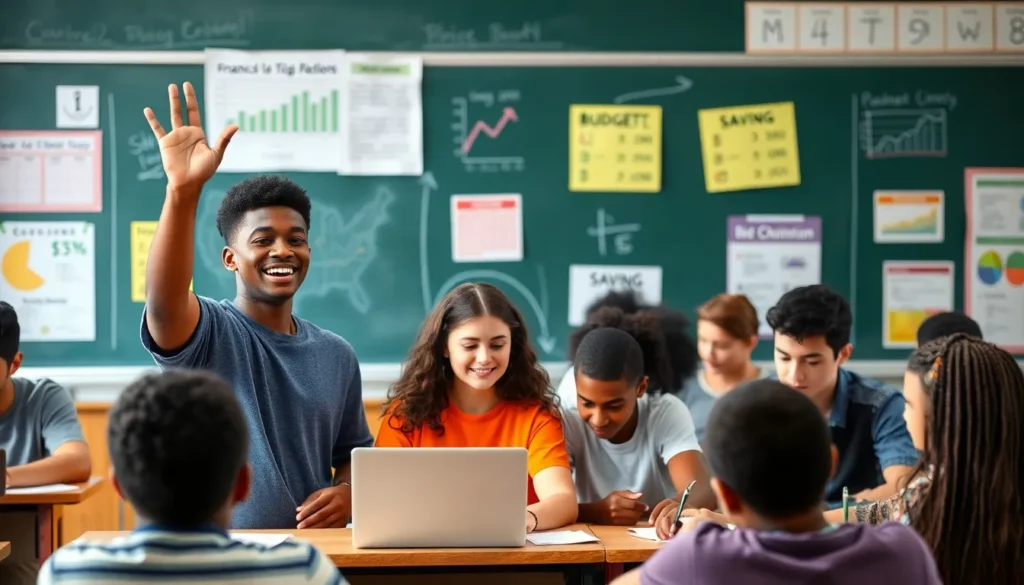Table of Contents
ToggleHigh school isn’t just about acing algebra and perfecting that awkward dance move; it’s also the perfect time to dive into the world of personal finance. Imagine walking into adulthood armed with the knowledge of budgeting, saving, and investing—like a superhero with a cape made of dollar bills. Personal finance education in high school equips students with essential skills to navigate their financial futures, turning them into savvy money managers before they even hit college.
But let’s be real. Most teens would rather binge-watch their favorite shows than sit through a lecture on compound interest. Yet, understanding personal finance can make the difference between living paycheck to paycheck and enjoying a life of financial freedom. So, why not make this topic engaging and fun? After all, who wouldn’t want to learn how to make their money work for them while still having time to hang out with friends?
What Is Personal Finance in High School
Personal finance in high school refers to the education and skills necessary for effective money management. Understanding concepts like budgeting, saving, and investing empowers students to navigate financial situations successfully. Learning these skills during high school prepares students for adult responsibilities, such as managing bills, loans, and savings accounts.
Students engage with various topics, including the importance of setting financial goals. Setting goals helps them prioritize spending and savings. They also learn about the impact of credit scores on future financial opportunities. Grasping how to maintain a good credit score influences decisions, such as applying for loans or renting apartments.
Real-world applications of personal finance curriculum matter significantly. Schools often incorporate projects that require creating budgets or tracking expenses. Interactive activities enable students to practice budgeting in simulated environments, improving their understanding of money management. Course content often includes discussions on student loans, credit cards, and the importance of saving for emergencies, giving students a comprehensive view of their financial landscape.
Incorporating technology into personal finance education enhances engagement. Many programs use apps or online tools, making lessons accessible and relatable. Understanding how to use online banking and budgeting apps prepares students for the digital financial environment. Innovative teaching methods increase interest levels and reduce the perception of finance as boring.
Personal finance education in high school inspires responsible money habits. Developing a solid foundation in these principles leads to informed financial decisions in adulthood. Students equipped with these skills contribute positively to their communities and economies.
Importance of Personal Finance Education

Personal finance education holds significant value for high school students. It equips them with skills for financial independence as they transition into adulthood.
Life Skills for Adulthood
Personal finance education teaches crucial life skills needed for adulthood. Students learn budgeting, allowing them to manage monthly expenses effectively. Saving skills foster a habit of setting aside money for future needs and emergencies. Investing knowledge encourages them to grow their wealth over time. These competencies create a foundation for responsible financial behavior, which leads to fewer debt-related stressors later in life. Ultimately, grasping these skills nurtures a sense of responsibility and prepares students for real-world financial challenges.
Financial Literacy Development
Developing financial literacy becomes essential during high school years. Understanding concepts like credit scores influences students’ abilities to secure loans and rental agreements in the future. Engaging projects often include creating budgets or simulating financial scenarios. Tools and apps help students track their expenses, making the learning process interactive. Regular exposure to these concepts cultivates informed decision-making. With solid financial literacy, students approach adulthood prepared for active participation in the economy, positively affecting their communities.
Key Components of Personal Finance
Personal finance encompasses critical skills that enable students to manage money effectively. High school education should focus on these components to prepare them for financial independence.
Budgeting and Saving
Budgeting constitutes a foundational element of personal finance. Students learn to track income and expenses, fostering responsible spending habits. Saving, linked closely to budgeting, teaches the importance of setting aside money for future goals. Short-term and long-term savings strategies allow students to prioritize needs over wants. Utilizing tools like budgeting apps enhances understanding. Real-life scenarios help clarify how budgeting affects personal finance decisions and long-term financial health.
Understanding Credit and Debt
Understanding credit scores plays a crucial role in financial literacy. Credit impacts opportunities such as loan approvals and rental agreements, highlighting its significance. Students should grasp the basics of building and maintaining good credit. Educating on interest rates and the consequences of debt promotes responsible borrowing. Managing debt effectively equips students with tools to make informed decisions when they encounter credit options. Addressing misconceptions about credit and debt fosters a culture of financial responsibility.
Investing Basics
Investing introduces students to the world of growing their money. Familiarity with stocks, bonds, and mutual funds is essential for financial growth. Students learn risk versus reward concepts, emphasizing long-term planning. Compounding interest serves as a key principle that students should understand. Knowledge of different investment vehicles enables them to make informed choices tailored to their financial goals. Engaging in simulated investing activities allows students to apply theoretical knowledge in practical scenarios.
Effective Ways to Teach Personal Finance
Teaching personal finance effectively involves using resources that resonate with high school students. Engaging materials capture interest and enhance understanding of financial concepts.
Classroom Resources and Tools
Utilizing interactive tools makes learning personal finance enjoyable. Budgeting apps help students track their expenses, connecting theoretical knowledge with practical application. Online platforms, such as Khan Academy, offer courses that simplify complex topics. Financial calculator websites enable students to visualize the impact of savings and investments. Educators can also introduce videos and podcasts to present real-world examples and expert insights, making lessons relatable and understandable. Incorporating these resources fosters an engaging environment that promotes financial literacy.
Engaging Activities for Students
Incorporating hands-on activities deepens students’ understanding of personal finance. Simulated stock market games allow them to experiment with investing strategies without real financial risk. Group projects that require creating budgets for hypothetical scenarios encourage teamwork and problem-solving. Financial literacy quizzes can assess knowledge while adding a competitive element to learning. Role-playing exercises, such as budgeting for monthly expenses, foster critical thinking about financial decisions. These engaging activities make learning personal finance relevant and enjoyable, ultimately preparing students for future financial challenges.
Personal finance education in high school plays a pivotal role in shaping financially responsible adults. By equipping students with essential skills like budgeting and investing, it lays the groundwork for a secure financial future. Engaging teaching methods and real-world applications make learning enjoyable and relevant, ensuring that students grasp the importance of money management.
As they develop financial literacy, they become empowered to make informed decisions that positively impact their lives and communities. Investing in personal finance education today cultivates a generation of savvy money managers ready to navigate the complexities of adulthood with confidence.




